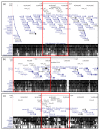The Role of SINE-VNTR-Alu (SVA) Retrotransposons in Shaping the Human Genome
- PMID: 31783611
- PMCID: PMC6928650
- DOI: 10.3390/ijms20235977
The Role of SINE-VNTR-Alu (SVA) Retrotransposons in Shaping the Human Genome
Abstract
Retrotransposons can alter the regulation of genes both transcriptionally and post-transcriptionally, through mechanisms such as binding transcription factors and alternative splicing of transcripts. SINE-VNTR-Alu (SVA) retrotransposons are the most recently evolved class of retrotransposable elements, found solely in primates, including humans. SVAs are preferentially found at genic, high GC loci, and have been termed "mobile CpG islands". We hypothesise that the ability of SVAs to mobilise, and their non-random distribution across the genome, may result in differential regulation of certain pathways. We analysed SVA distribution patterns across the human reference genome and identified over-representation of SVAs at zinc finger gene clusters. Zinc finger proteins are able to bind to and repress SVA function through transcriptional and epigenetic mechanisms, and the interplay between SVAs and zinc fingers has been proposed as a major feature of genome evolution. We describe observations relating to the clustering patterns of both reference SVAs and polymorphic SVA insertions at zinc finger gene loci, suggesting that the evolution of this network may be ongoing in humans. Further, we propose a mechanism to direct future research and validation efforts, in which the interplay between zinc fingers and their epigenetic modulation of SVAs may regulate a network of zinc finger genes, with the potential for wider transcriptional consequences.
Keywords: SVA; ZNF; evolution; polymorphism; primate; retrotransposon; zinc finger protein.
Conflict of interest statement
The authors declare no conflict of interest.
Figures







Similar articles
-
A SINE-VNTR-Alu in the LRIG2 Promoter Is Associated with Gene Expression at the Locus.Int J Mol Sci. 2020 Nov 11;21(22):8486. doi: 10.3390/ijms21228486. Int J Mol Sci. 2020. PMID: 33187279 Free PMC article.
-
ZNF91 deletion in human embryonic stem cells leads to ectopic activation of SVA retrotransposons and up-regulation of KRAB zinc finger gene clusters.Genome Res. 2021 Apr;31(4):551-563. doi: 10.1101/gr.265348.120. Epub 2021 Mar 15. Genome Res. 2021. PMID: 33722937 Free PMC article.
-
SVA retrotransposons: Evolution and genetic instability.Semin Cancer Biol. 2010 Aug;20(4):234-45. doi: 10.1016/j.semcancer.2010.04.001. Epub 2010 Apr 21. Semin Cancer Biol. 2010. PMID: 20416380 Free PMC article. Review.
-
Mini-heterochromatin domains constrain the cis-regulatory impact of SVA transposons in human brain development and disease.Nat Struct Mol Biol. 2024 Oct;31(10):1543-1556. doi: 10.1038/s41594-024-01320-8. Epub 2024 Jun 4. Nat Struct Mol Biol. 2024. PMID: 38834915 Free PMC article.
-
Mechanisms of disease-associated SINE-VNTR-Alus.Exp Biol Med (Maywood). 2022 May;247(9):756-764. doi: 10.1177/15353702221082612. Epub 2022 Apr 6. Exp Biol Med (Maywood). 2022. PMID: 35387528 Free PMC article. Review.
Cited by
-
An assessment of bioinformatics tools for the detection of human endogenous retroviral insertions in short-read genome sequencing data.Front Bioinform. 2023 Feb 8;2:1062328. doi: 10.3389/fbinf.2022.1062328. eCollection 2022. Front Bioinform. 2023. PMID: 36845320 Free PMC article.
-
CRISPR deletion of a SINE-VNTR-Alu (SVA_67) retrotransposon demonstrates its ability to differentially modulate gene expression at the MAPT locus.Front Neurol. 2023 Sep 29;14:1273036. doi: 10.3389/fneur.2023.1273036. eCollection 2023. Front Neurol. 2023. PMID: 37840928 Free PMC article.
-
Causes and Consequences of Varying Transposable Element Activity: An Evolutionary Perspective.Annu Rev Genomics Hum Genet. 2024 Aug;25(1):1-25. doi: 10.1146/annurev-genom-120822-105708. Epub 2024 Aug 6. Annu Rev Genomics Hum Genet. 2024. PMID: 38603565 Free PMC article. Review.
-
The landscape of human SVA retrotransposons.Nucleic Acids Res. 2023 Nov 27;51(21):11453-11465. doi: 10.1093/nar/gkad821. Nucleic Acids Res. 2023. PMID: 37823611 Free PMC article.
-
Expression Quantitative Trait Loci (eQTLs) Associated with Retrotransposons Demonstrate their Modulatory Effect on the Transcriptome.Int J Mol Sci. 2021 Jun 12;22(12):6319. doi: 10.3390/ijms22126319. Int J Mol Sci. 2021. PMID: 34204806 Free PMC article.
References
MeSH terms
Substances
Grants and funding
LinkOut - more resources
Full Text Sources
Miscellaneous

